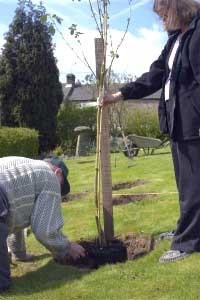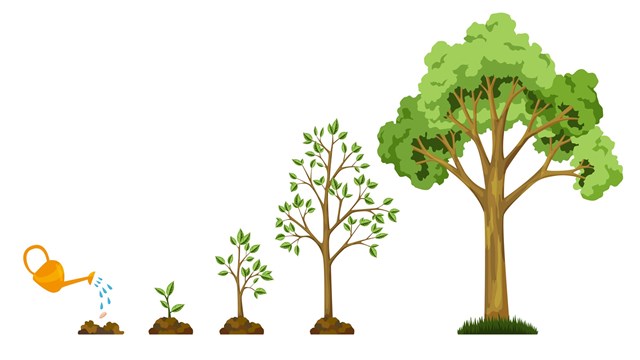
Imagine how stark life would be without the sheltering beauty of trees. From the majestic architecture of large shade trees to the soft colors of spring blossoming ornamentals, trees are major contributors to our landscapes, and our lives.
Trees soften the landscape visually and add a feeling of serenity. During the growing season, a tree's leaves act to muffle sound and provide shade. Trees filter the air we breathe by taking in carbon dioxide, sulfur dioxide, carbon monoxide, and return life-supporting oxygen to us. Planted in the proper place, trees can screen undesirable views and protect us from winter winds. The bond between people and trees is elemental and symbiotic—it's no wonder that people have an emotional investment in them.
Forest-grown trees benefit from the annual fall of leaves, which slowly decay forming the loose nutrient rich soils needed to support them. Colonies of mychorrizal fungi flourish in this environment and bond with root hairs to increase their ability to absorb water and nutrients. Trees growing in urban settings are often challenged to grow in compacted soils with low organic content, and in competition with aggressive turf root systems for any fertilizer that is applied during the growing season.
No Mulch Volcanoes!
Proper care of trees will help to lengthen their time in our landscapes. The care of trees should begin below ground by encouraging and maintaining a healthy root system. Soil samples should be taken on any unfamiliar property, and sent to a lab specializing in agricultural soil testing.
With the soil test results as guide, it's time to make fertilizer choices. Granular fertilizers can be used, but fertilization is best accomplished by hydraulic deep root feeding. Hydraulic deep root feeding is the injection of fertilizers and soil conditioners into the first four to 10 inches of soil, where the majority of feeder roots exist. The fertilizer is injected under 150 to 200 pounds of pressure per square-inch, and has the added benefit of aerating the soil. Fertilizers are available in slow-release formulations of different percentages allowing for a two-year feeding cycle. Done correctly, a portion of the trees on the property can be fed each year, avoiding a large single billing.
Mulch is commonly installed at the base of trees for its decorative aspect, to suppress weed growth, and to retain moisture. Two to three inches should be used up to the trunk of the tree, but not piled up and around the trunk. Too much mulch around the tree will inhibit aspiration through the bark, and cause the production of adventitious roots as the tree tries to adapt to the artificial change in grade. These factors combine to compromise the health of the tree. "No mulch volcanoes!" has become a horticultural battle cry and should be heeded.
A Word on Pruning
Pruning is an art and a basic understanding of tree biology and the architecture of different tree species is necessary for success. On the most basic level, pruning to maintain the health of a tree is accomplished by removing dead, broken, crossing, or diseased branches. In each case the protective layer of bark has been injured either mechanically or by disease pathogens, and the spread of decay into the trunk of the tree must be blocked.
Specific procedures have been established for branch removal. Each time a branch is removed, it sets up an automatic response within the tree. When a cut is made, the tree automatically produces a wall of protective cells to prevent the spread of decay. In order to cause the least damage, each branch must be removed at the branch collar by cutting down through the bark ridge. Cutting at the bark ridge (called 'collar cutting') will initiate the wound response and will promote quicker healing, as cells in this area are the fastest growing.
Shade trees, ornamentals, and evergreens are pruned in different ways, and for different reasons. Shade trees usually need little more than basic pruning to maintain their health, with ornamental trees especially crabapples responding to a more formal style of pruning
The American National Standards Institute (ANSI) has established standards for all aspects of tree care (ANSI - A300) as a guide for all tree care professionals, and your landscape services provider should be familiar with them.
No Bugs on Me
The trees are fed and pruned—now it's time to manage insects and disease. Any person applying pesticides in New Jersey must be licensed and certified by the state. Your service provider will be happy to supply you with copies of licenses for all plant health care technicians working on your site.
Pesticides have changed a great deal in the past ten years as have the way in which they are applied. Out of concern for the environment most plant health care companies at least offer integrated pest management programs, or IPMs. IPM programs are centered around regular monitoring of each site. The monitoring procedure involves inspection of all plant material on site for evidence of insect pests, and disease. Pesticides are only applied when insect populations or level disease infection surpasses established economic thresholds. This strategy reduces the amount of pesticides released into the environment while maintaining plant health.
Costs for this service are higher on a residential basis because of labor costs involved in regular monitoring, but commercial maintenance companies can include the monitoring with their regular weekly visits.
Pesticides formulations have become more targeted in recent years, eliminating the old varieties that simply killed everything. The residual effects have been greatly reduced and pesticides remain toxic for a shorter period of time. More biorational products are available that kill by limiting an insect's ability to molt or reproduce. All in all, it's a greener industry than it ever was.
So look to the roots first, then prune, and address any insect or disease issues then take a well-deserved break, and enjoy the newness of spring!
Rob Kopf is an arborist with DuBrow's Nurseries in Livingston, New Jersey.






Comments
Leave a Comment